BMW 3 SERIES SPORTS WAGON 2015 F31 Owner's Manual
Manufacturer: BMW, Model Year: 2015, Model line: 3 SERIES SPORTS WAGON, Model: BMW 3 SERIES SPORTS WAGON 2015 F31Pages: 255, PDF Size: 5.6 MB
Page 131 of 255
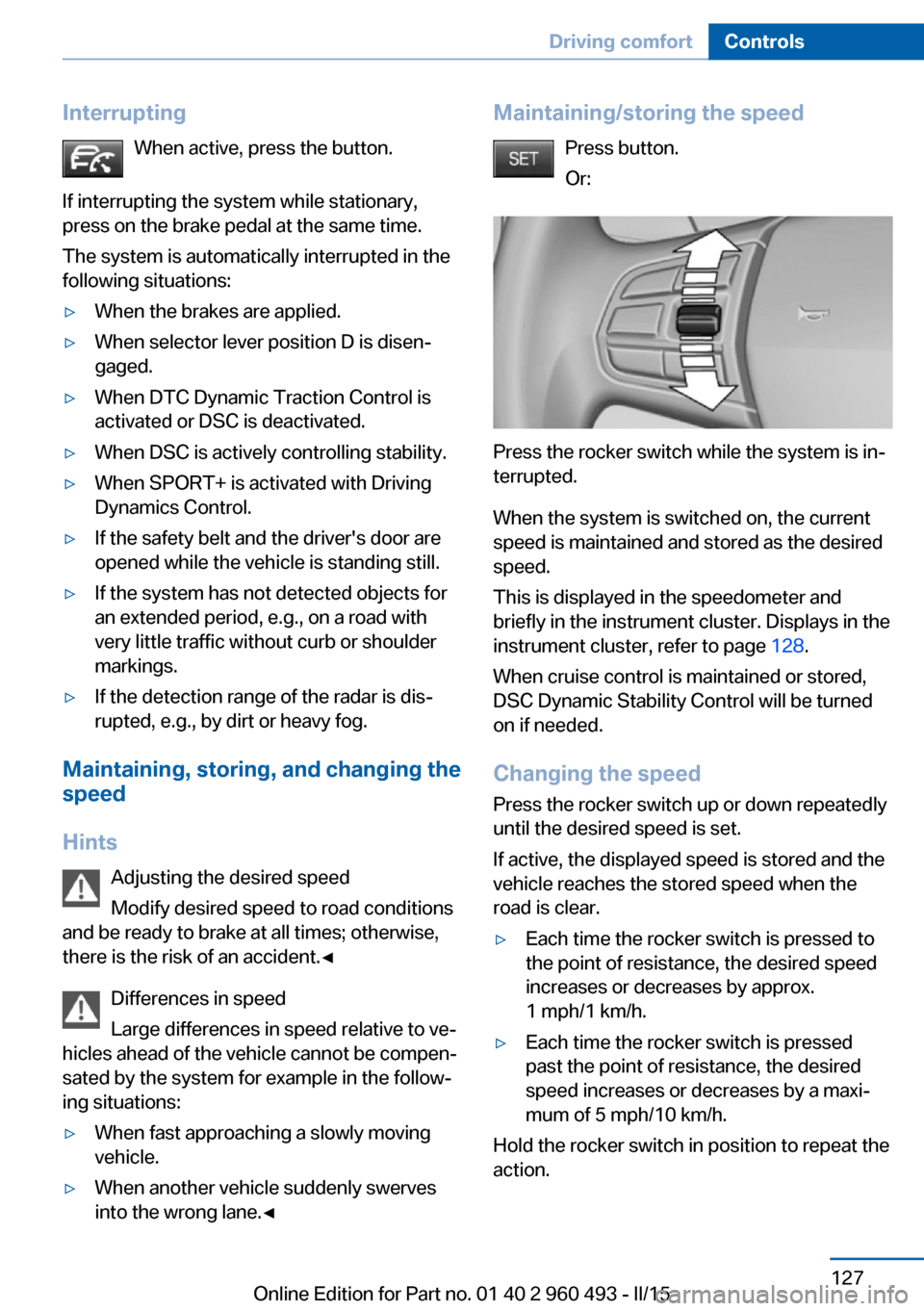
InterruptingWhen active, press the button.
If interrupting the system while stationary,
press on the brake pedal at the same time.
The system is automatically interrupted in the
following situations:âˇWhen the brakes are applied.âˇWhen selector lever position D is disenâ
gaged.âˇWhen DTC Dynamic Traction Control is
activated or DSC is deactivated.âˇWhen DSC is actively controlling stability.âˇWhen SPORT+ is activated with Driving
Dynamics Control.âˇIf the safety belt and the driver's door are
opened while the vehicle is standing still.âˇIf the system has not detected objects for
an extended period, e.g., on a road with
very little traffic without curb or shoulder
markings.âˇIf the detection range of the radar is disâ
rupted, e.g., by dirt or heavy fog.
Maintaining, storing, and changing the
speed
Hints Adjusting the desired speedModify desired speed to road conditions
and be ready to brake at all times; otherwise,
there is the risk of an accident.â
Differences in speed
Large differences in speed relative to veâ
hicles ahead of the vehicle cannot be compenâ
sated by the system for example in the followâ
ing situations:
âˇWhen fast approaching a slowly moving
vehicle.âˇWhen another vehicle suddenly swerves
into the wrong lane.âMaintaining/storing the speed
Press button.
Or:
Press the rocker switch while the system is inâ
terrupted.
When the system is switched on, the current
speed is maintained and stored as the desired
speed.
This is displayed in the speedometer and
briefly in the instrument cluster. Displays in the
instrument cluster, refer to page 128.
When cruise control is maintained or stored,
DSC Dynamic Stability Control will be turned
on if needed.
Changing the speed
Press the rocker switch up or down repeatedly
until the desired speed is set.
If active, the displayed speed is stored and the vehicle reaches the stored speed when the
road is clear.
âˇEach time the rocker switch is pressed to
the point of resistance, the desired speed
increases or decreases by approx.
1 mph/1 km/h.âˇEach time the rocker switch is pressed
past the point of resistance, the desired
speed increases or decreases by a maxiâ
mum of 5 mph/10 km/h.
Hold the rocker switch in position to repeat the
action.
Seite 127Driving comfortControls127
Online Edition for Part no. 01 40 2 960 493 - II/15
Page 132 of 255
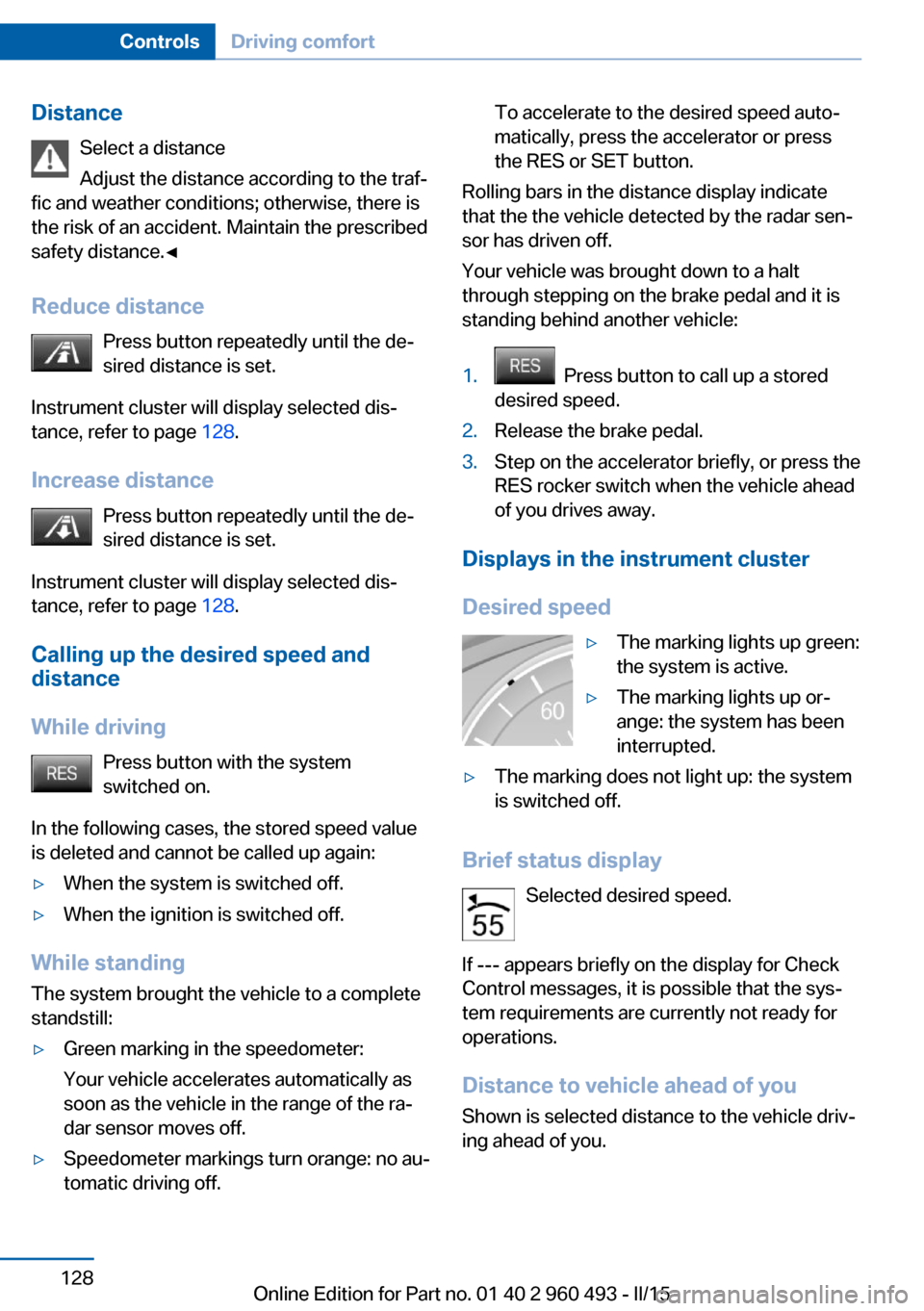
DistanceSelect a distance
Adjust the distance according to the trafâ
fic and weather conditions; otherwise, there is
the risk of an accident. Maintain the prescribed
safety distance.â
Reduce distance Press button repeatedly until the deâ
sired distance is set.
Instrument cluster will display selected disâ
tance, refer to page 128.
Increase distance Press button repeatedly until the deâ
sired distance is set.
Instrument cluster will display selected disâ
tance, refer to page 128.
Calling up the desired speed and
distance
While driving Press button with the system
switched on.
In the following cases, the stored speed value
is deleted and cannot be called up again:âˇWhen the system is switched off.âˇWhen the ignition is switched off.
While standing
The system brought the vehicle to a complete
standstill:
âˇGreen marking in the speedometer:
Your vehicle accelerates automatically as
soon as the vehicle in the range of the raâ
dar sensor moves off.âˇSpeedometer markings turn orange: no auâ
tomatic driving off.To accelerate to the desired speed autoâ
matically, press the accelerator or press
the RES or SET button.
Rolling bars in the distance display indicate
that the the vehicle detected by the radar senâ
sor has driven off.
Your vehicle was brought down to a halt
through stepping on the brake pedal and it is
standing behind another vehicle:
1. Press button to call up a stored
desired speed.2.Release the brake pedal.3.Step on the accelerator briefly, or press the
RES rocker switch when the vehicle ahead
of you drives away.
Displays in the instrument cluster
Desired speed
âˇThe marking lights up green:
the system is active.âˇThe marking lights up orâ
ange: the system has been
interrupted.âˇThe marking does not light up: the system
is switched off.
Brief status display
Selected desired speed.
If --- appears briefly on the display for Check
Control messages, it is possible that the sysâ
tem requirements are currently not ready for
operations.
Distance to vehicle ahead of you Shown is selected distance to the vehicle drivâ
ing ahead of you.
Seite 128ControlsDriving comfort128
Online Edition for Part no. 01 40 2 960 493 - II/15
Page 133 of 255
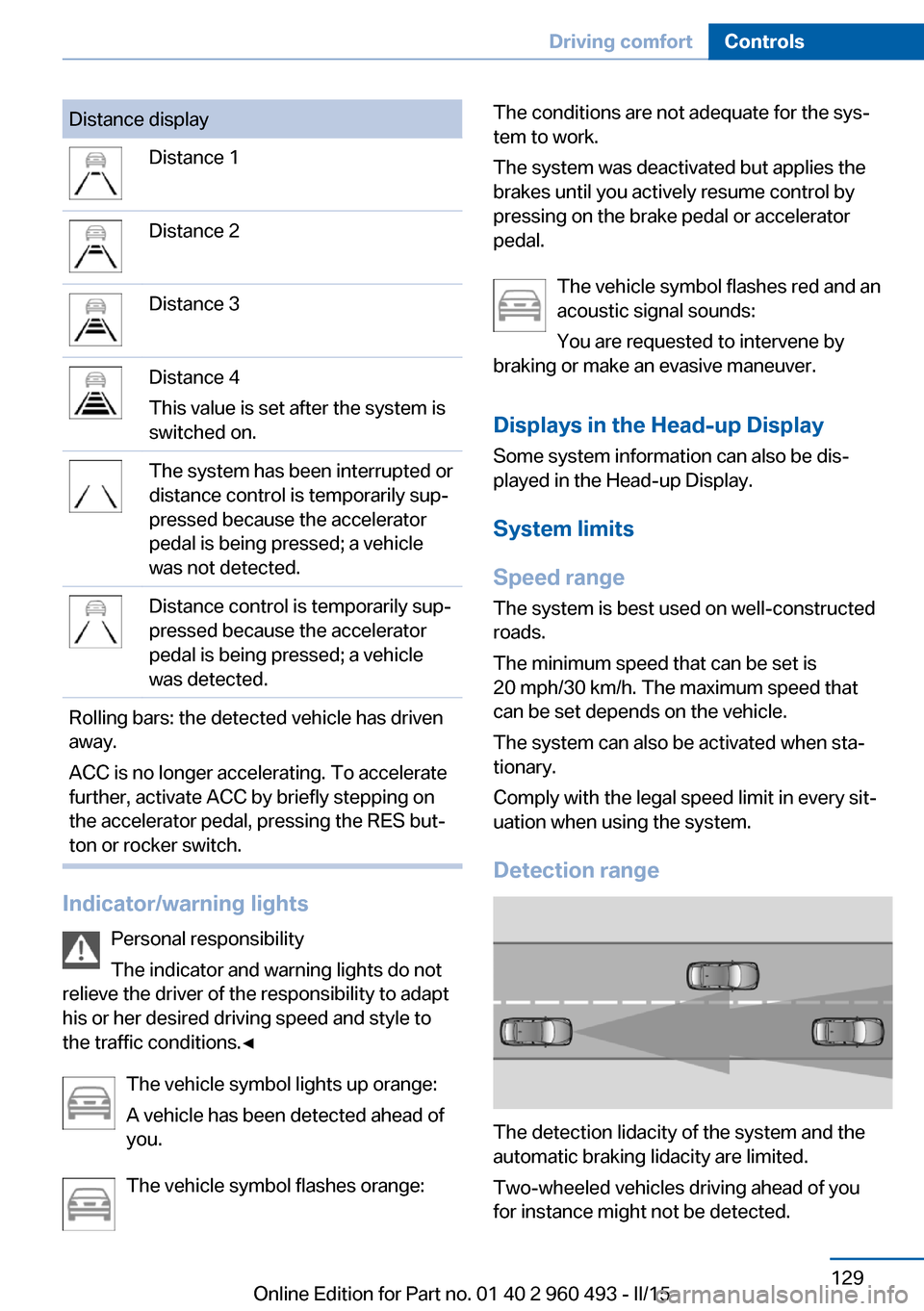
Distance displayDistance 1Distance 2Distance 3Distance 4
This value is set after the system is
switched on.The system has been interrupted or
distance control is temporarily supâ
pressed because the accelerator
pedal is being pressed; a vehicle
was not detected.Distance control is temporarily supâ
pressed because the accelerator
pedal is being pressed; a vehicle
was detected.Rolling bars: the detected vehicle has driven
away.
ACC is no longer accelerating. To accelerate
further, activate ACC by briefly stepping on
the accelerator pedal, pressing the RES butâ
ton or rocker switch.
Indicator/warning lights
Personal responsibility
The indicator and warning lights do not
relieve the driver of the responsibility to adapt
his or her desired driving speed and style to
the traffic conditions.â
The vehicle symbol lights up orange:
A vehicle has been detected ahead of
you.
The vehicle symbol flashes orange:
The conditions are not adequate for the sysâ
tem to work.
The system was deactivated but applies the
brakes until you actively resume control by
pressing on the brake pedal or accelerator
pedal.
The vehicle symbol flashes red and an
acoustic signal sounds:
You are requested to intervene by
braking or make an evasive maneuver.
Displays in the Head-up Display Some system information can also be disâ
played in the Head-up Display.
System limits
Speed range The system is best used on well-constructed
roads.
The minimum speed that can be set is
20 mph/30 km/h. The maximum speed that
can be set depends on the vehicle.
The system can also be activated when staâ
tionary.
Comply with the legal speed limit in every sitâ
uation when using the system.
Detection range
The detection lidacity of the system and the
automatic braking lidacity are limited.
Two-wheeled vehicles driving ahead of you
for instance might not be detected.
Seite 129Driving comfortControls129
Online Edition for Part no. 01 40 2 960 493 - II/15
Page 134 of 255
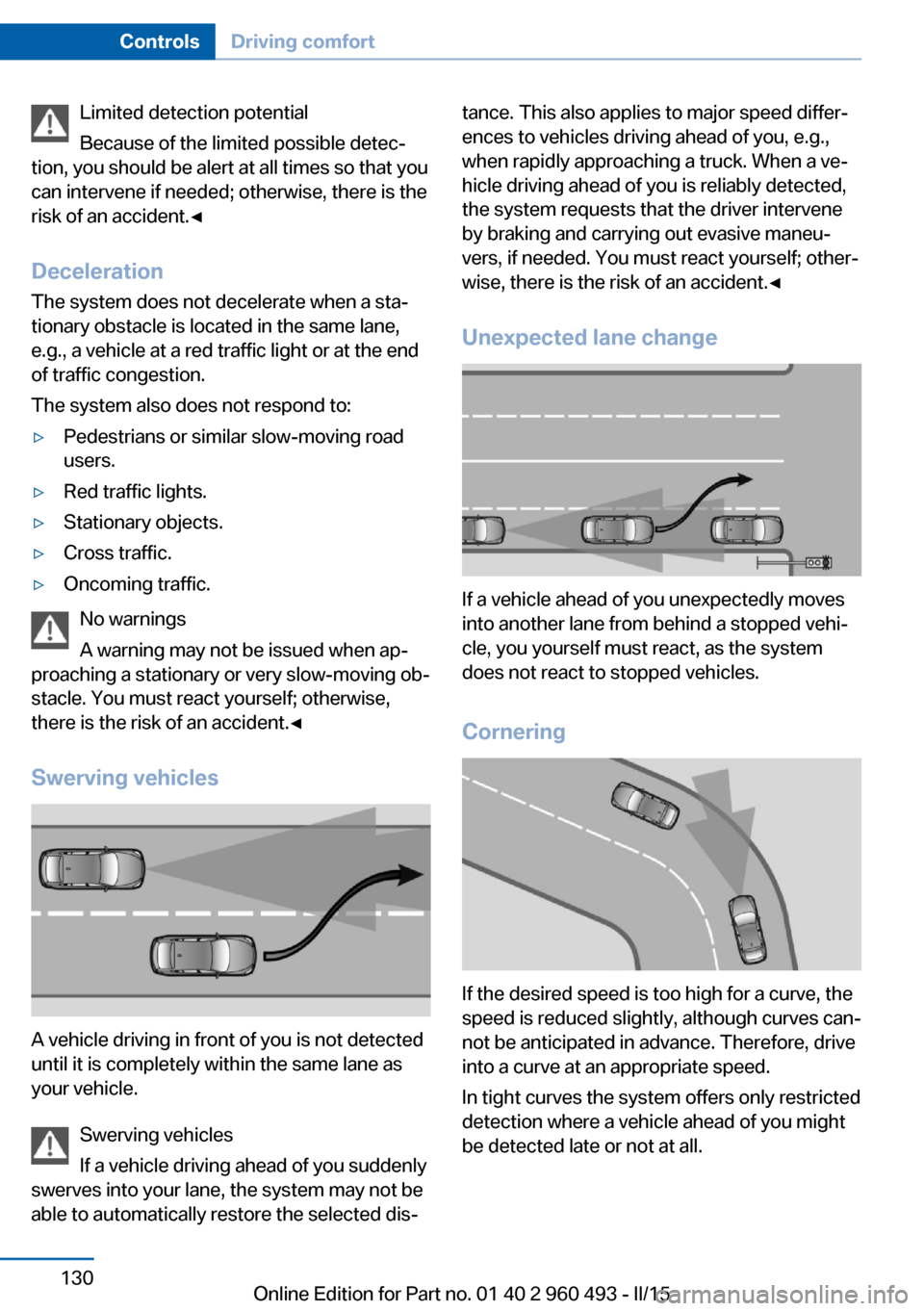
Limited detection potential
Because of the limited possible detecâ
tion, you should be alert at all times so that you
can intervene if needed; otherwise, there is the
risk of an accident.â
Deceleration
The system does not decelerate when a staâ
tionary obstacle is located in the same lane,
e.g., a vehicle at a red traffic light or at the end
of traffic congestion.
The system also does not respond to:âˇPedestrians or similar slow-moving road
users.âˇRed traffic lights.âˇStationary objects.âˇCross traffic.âˇOncoming traffic.
No warnings
A warning may not be issued when apâ
proaching a stationary or very slow-moving obâ
stacle. You must react yourself; otherwise,
there is the risk of an accident.â
Swerving vehicles
A vehicle driving in front of you is not detected
until it is completely within the same lane as
your vehicle.
Swerving vehicles
If a vehicle driving ahead of you suddenly
swerves into your lane, the system may not be
able to automatically restore the selected disâ
tance. This also applies to major speed differâ
ences to vehicles driving ahead of you, e.g.,
when rapidly approaching a truck. When a veâ
hicle driving ahead of you is reliably detected,
the system requests that the driver intervene
by braking and carrying out evasive maneuâ
vers, if needed. You must react yourself; otherâ
wise, there is the risk of an accident.â
Unexpected lane change
If a vehicle ahead of you unexpectedly moves
into another lane from behind a stopped vehiâ
cle, you yourself must react, as the system
does not react to stopped vehicles.
Cornering
If the desired speed is too high for a curve, the
speed is reduced slightly, although curves canâ
not be anticipated in advance. Therefore, drive
into a curve at an appropriate speed.
In tight curves the system offers only restricted
detection where a vehicle ahead of you might
be detected late or not at all.
Seite 130ControlsDriving comfort130
Online Edition for Part no. 01 40 2 960 493 - II/15
Page 135 of 255
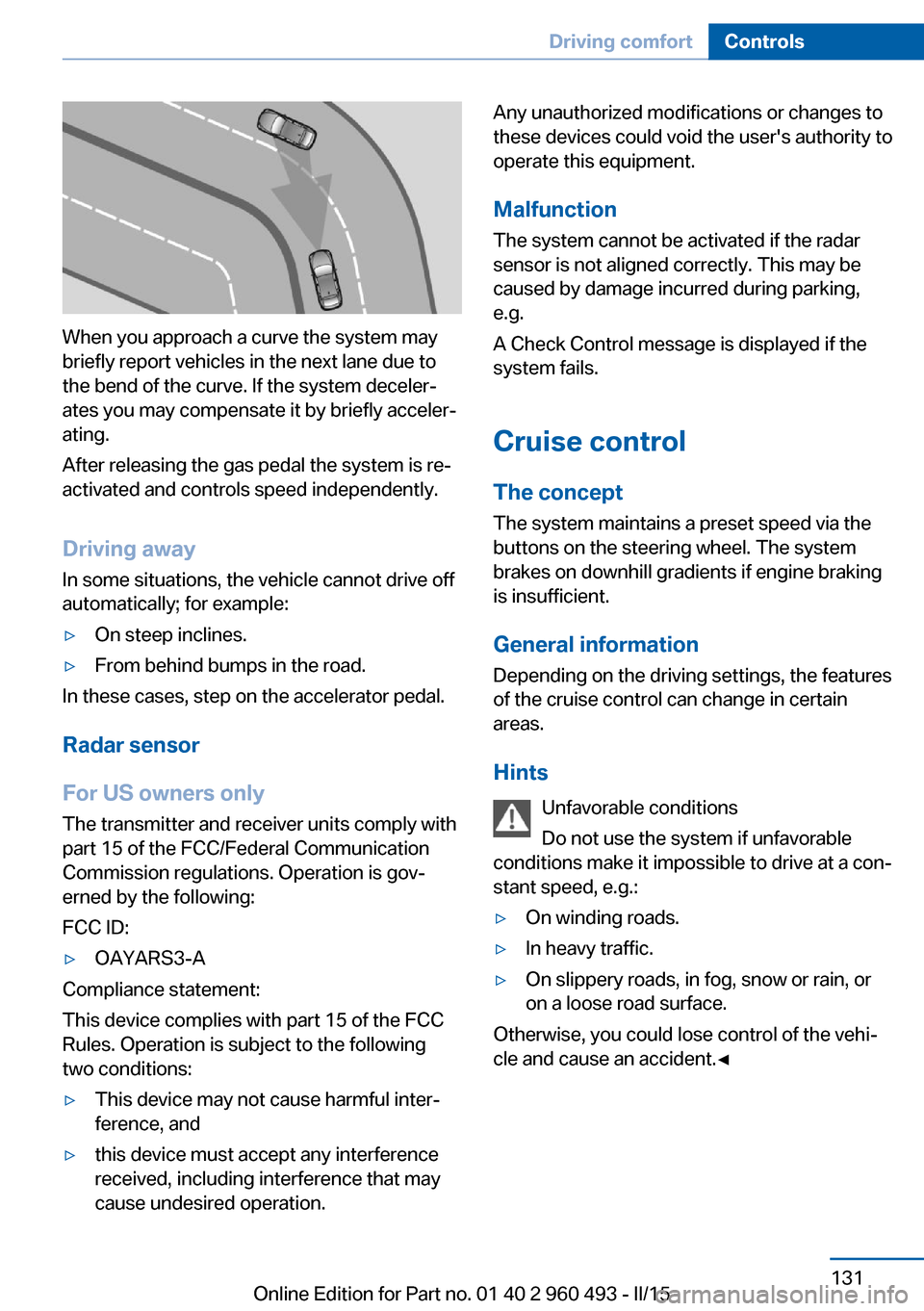
When you approach a curve the system may
briefly report vehicles in the next lane due to
the bend of the curve. If the system decelerâ
ates you may compensate it by briefly accelerâ
ating.
After releasing the gas pedal the system is reâ
activated and controls speed independently.
Driving away In some situations, the vehicle cannot drive off
automatically; for example:
âˇOn steep inclines.âˇFrom behind bumps in the road.
In these cases, step on the accelerator pedal.
Radar sensor
For US owners only
The transmitter and receiver units comply with
part 15 of the FCC/Federal Communication
Commission regulations. Operation is govâ
erned by the following:
FCC ID:
âˇOAYARS3-A
Compliance statement:
This device complies with part 15 of the FCC
Rules. Operation is subject to the following
two conditions:
âˇThis device may not cause harmful interâ
ference, andâˇthis device must accept any interference
received, including interference that may
cause undesired operation.Any unauthorized modifications or changes to
these devices could void the user's authority to
operate this equipment.
Malfunction
The system cannot be activated if the radar sensor is not aligned correctly. This may be
caused by damage incurred during parking,
e.g.
A Check Control message is displayed if the
system fails.
Cruise control The concept The system maintains a preset speed via the
buttons on the steering wheel. The system
brakes on downhill gradients if engine braking
is insufficient.
General information
Depending on the driving settings, the features
of the cruise control can change in certain
areas.
Hints Unfavorable conditions
Do not use the system if unfavorable
conditions make it impossible to drive at a conâ
stant speed, e.g.:âˇOn winding roads.âˇIn heavy traffic.âˇOn slippery roads, in fog, snow or rain, or
on a loose road surface.
Otherwise, you could lose control of the vehiâ
cle and cause an accident.â
Seite 131Driving comfortControls131
Online Edition for Part no. 01 40 2 960 493 - II/15
Page 136 of 255
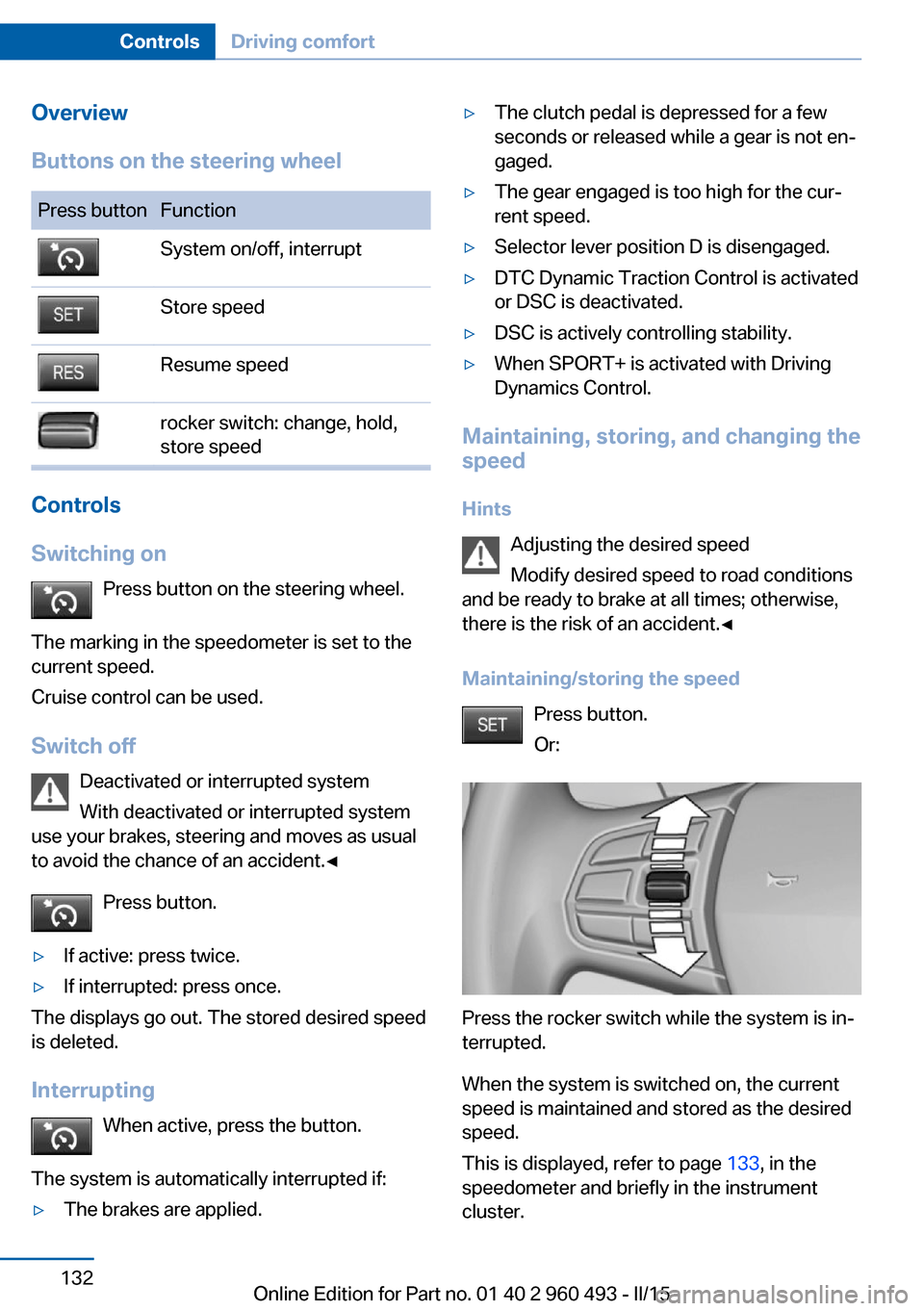
Overview
Buttons on the steering wheelPress buttonFunctionSystem on/off, interruptStore speedResume speedrocker switch: change, hold,
store speed
Controls
Switching on Press button on the steering wheel.
The marking in the speedometer is set to the
current speed.
Cruise control can be used.
Switch off Deactivated or interrupted system
With deactivated or interrupted system
use your brakes, steering and moves as usual
to avoid the chance of an accident.â
Press button.
âˇIf active: press twice.âˇIf interrupted: press once.
The displays go out. The stored desired speed
is deleted.
Interrupting When active, press the button.
The system is automatically interrupted if:
âˇThe brakes are applied.âˇThe clutch pedal is depressed for a few
seconds or released while a gear is not enâ
gaged.âˇThe gear engaged is too high for the curâ
rent speed.âˇSelector lever position D is disengaged.âˇDTC Dynamic Traction Control is activated
or DSC is deactivated.âˇDSC is actively controlling stability.âˇWhen SPORT+ is activated with Driving
Dynamics Control.
Maintaining, storing, and changing the
speed
Hints Adjusting the desired speed
Modify desired speed to road conditions
and be ready to brake at all times; otherwise,
there is the risk of an accident.â
Maintaining/storing the speed Press button.
Or:
Press the rocker switch while the system is inâ
terrupted.
When the system is switched on, the current
speed is maintained and stored as the desired
speed.
This is displayed, refer to page 133, in the
speedometer and briefly in the instrument
cluster.
Seite 132ControlsDriving comfort132
Online Edition for Part no. 01 40 2 960 493 - II/15
Page 137 of 255
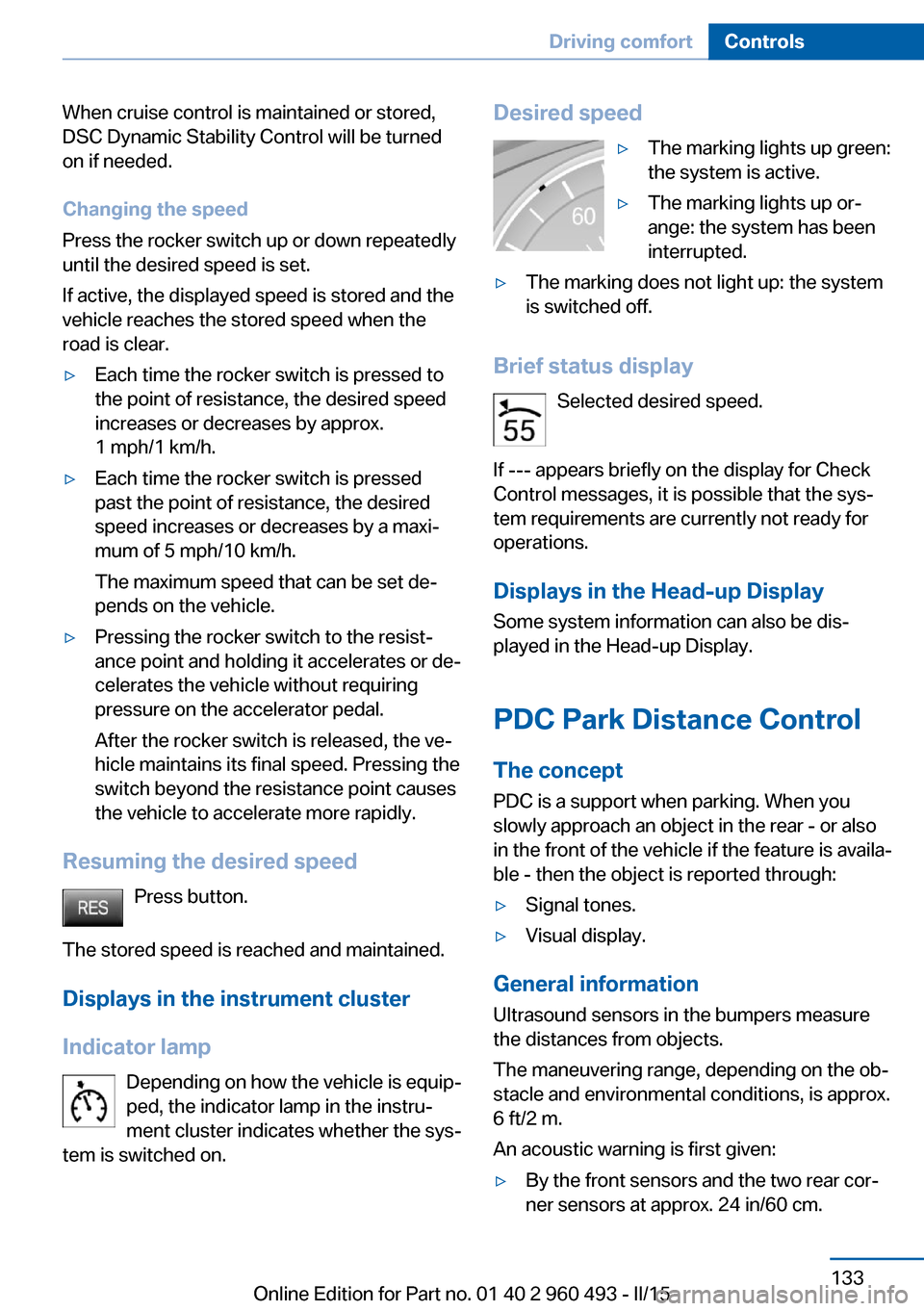
When cruise control is maintained or stored,
DSC Dynamic Stability Control will be turned
on if needed.
Changing the speed
Press the rocker switch up or down repeatedly
until the desired speed is set.
If active, the displayed speed is stored and the
vehicle reaches the stored speed when the
road is clear.âˇEach time the rocker switch is pressed to
the point of resistance, the desired speed
increases or decreases by approx.
1 mph/1 km/h.âˇEach time the rocker switch is pressed
past the point of resistance, the desired
speed increases or decreases by a maxiâ
mum of 5 mph/10 km/h.
The maximum speed that can be set deâ
pends on the vehicle.âˇPressing the rocker switch to the resistâ
ance point and holding it accelerates or deâ
celerates the vehicle without requiring
pressure on the accelerator pedal.
After the rocker switch is released, the veâ
hicle maintains its final speed. Pressing the
switch beyond the resistance point causes
the vehicle to accelerate more rapidly.
Resuming the desired speed
Press button.
The stored speed is reached and maintained. Displays in the instrument cluster
Indicator lamp Depending on how the vehicle is equipâ
ped, the indicator lamp in the instruâ
ment cluster indicates whether the sysâ
tem is switched on.
Desired speedâˇThe marking lights up green:
the system is active.âˇThe marking lights up orâ
ange: the system has been
interrupted.âˇThe marking does not light up: the system
is switched off.
Brief status display
Selected desired speed.
If --- appears briefly on the display for Check
Control messages, it is possible that the sysâ
tem requirements are currently not ready for
operations.
Displays in the Head-up Display Some system information can also be disâplayed in the Head-up Display.
PDC Park Distance Control
The concept PDC is a support when parking. When you
slowly approach an object in the rear - or also
in the front of the vehicle if the feature is availaâ
ble - then the object is reported through:
âˇSignal tones.âˇVisual display.
General information
Ultrasound sensors in the bumpers measure
the distances from objects.
The maneuvering range, depending on the obâ
stacle and environmental conditions, is approx.
6 ft/2 m.
An acoustic warning is first given:
âˇBy the front sensors and the two rear corâ
ner sensors at approx. 24 in/60 cm.Seite 133Driving comfortControls133
Online Edition for Part no. 01 40 2 960 493 - II/15
Page 138 of 255
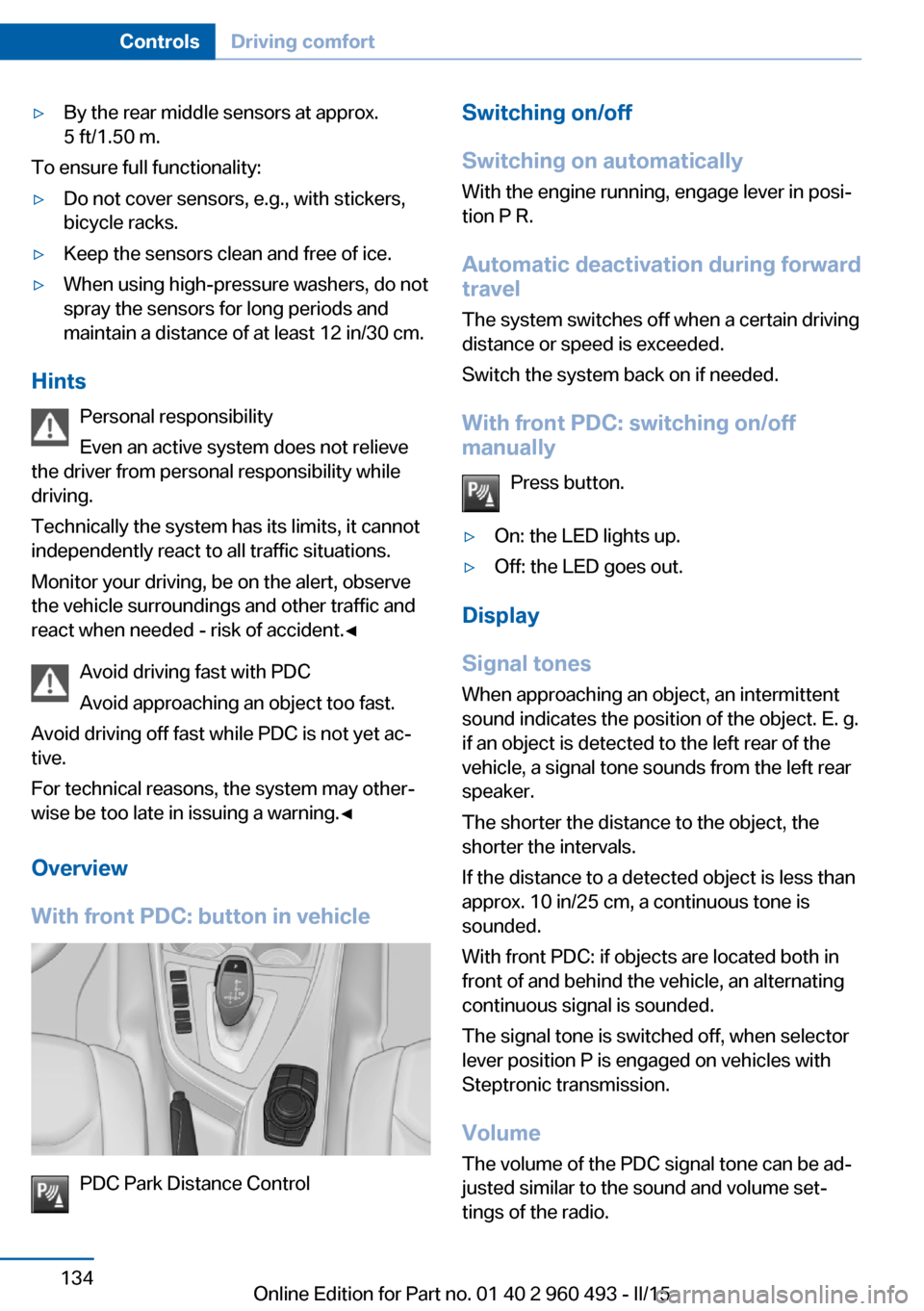
âˇBy the rear middle sensors at approx.
5 ft/1.50 m.
To ensure full functionality:
âˇDo not cover sensors, e.g., with stickers,
bicycle racks.âˇKeep the sensors clean and free of ice.âˇWhen using high-pressure washers, do not
spray the sensors for long periods and
maintain a distance of at least 12 in/30 cm.
Hints
Personal responsibility
Even an active system does not relieve
the driver from personal responsibility while
driving.
Technically the system has its limits, it cannot
independently react to all traffic situations.
Monitor your driving, be on the alert, observe
the vehicle surroundings and other traffic and
react when needed - risk of accident.â
Avoid driving fast with PDC
Avoid approaching an object too fast.
Avoid driving off fast while PDC is not yet acâ
tive.
For technical reasons, the system may otherâ
wise be too late in issuing a warning.â
Overview
With front PDC: button in vehicle
PDC Park Distance Control
Switching on/off
Switching on automatically With the engine running, engage lever in posiâ
tion P R.
Automatic deactivation during forward travel
The system switches off when a certain driving
distance or speed is exceeded.
Switch the system back on if needed.
With front PDC: switching on/off
manually
Press button.âˇOn: the LED lights up.âˇOff: the LED goes out.
Display
Signal tones When approaching an object, an intermittent
sound indicates the position of the object. E. g.
if an object is detected to the left rear of the
vehicle, a signal tone sounds from the left rear
speaker.
The shorter the distance to the object, the shorter the intervals.
If the distance to a detected object is less than
approx. 10 in/25 cm, a continuous tone is
sounded.
With front PDC: if objects are located both in
front of and behind the vehicle, an alternating
continuous signal is sounded.
The signal tone is switched off, when selector
lever position P is engaged on vehicles with
Steptronic transmission.
Volume The volume of the PDC signal tone can be adâ
justed similar to the sound and volume setâ
tings of the radio.
Seite 134ControlsDriving comfort134
Online Edition for Part no. 01 40 2 960 493 - II/15
Page 139 of 255
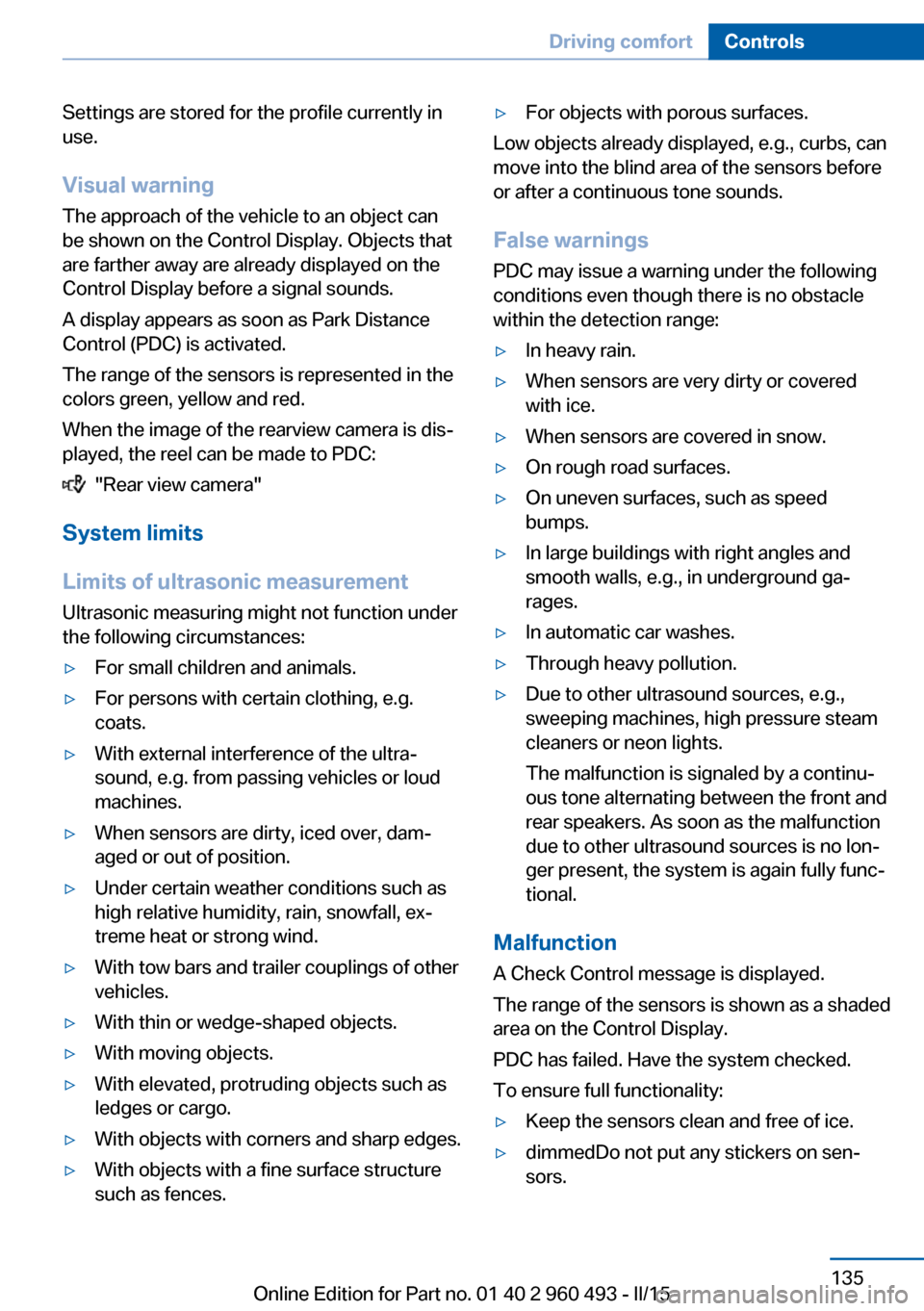
Settings are stored for the profile currently in
use.
Visual warning
The approach of the vehicle to an object can
be shown on the Control Display. Objects that
are farther away are already displayed on the
Control Display before a signal sounds.
A display appears as soon as Park Distance
Control (PDC) is activated.
The range of the sensors is represented in the
colors green, yellow and red.
When the image of the rearview camera is disâ
played, the reel can be made to PDC:
"Rear view camera"
System limits
Limits of ultrasonic measurement
Ultrasonic measuring might not function under
the following circumstances:
âˇFor small children and animals.âˇFor persons with certain clothing, e.g.
coats.âˇWith external interference of the ultraâ
sound, e.g. from passing vehicles or loud
machines.âˇWhen sensors are dirty, iced over, damâ
aged or out of position.âˇUnder certain weather conditions such as
high relative humidity, rain, snowfall, exâ
treme heat or strong wind.âˇWith tow bars and trailer couplings of other
vehicles.âˇWith thin or wedge-shaped objects.âˇWith moving objects.âˇWith elevated, protruding objects such as
ledges or cargo.âˇWith objects with corners and sharp edges.âˇWith objects with a fine surface structure
such as fences.âˇFor objects with porous surfaces.
Low objects already displayed, e.g., curbs, can
move into the blind area of the sensors before
or after a continuous tone sounds.
False warnings
PDC may issue a warning under the following conditions even though there is no obstacle
within the detection range:
âˇIn heavy rain.âˇWhen sensors are very dirty or covered
with ice.âˇWhen sensors are covered in snow.âˇOn rough road surfaces.âˇOn uneven surfaces, such as speed
bumps.âˇIn large buildings with right angles and
smooth walls, e.g., in underground gaâ
rages.âˇIn automatic car washes.âˇThrough heavy pollution.âˇDue to other ultrasound sources, e.g.,
sweeping machines, high pressure steam
cleaners or neon lights.
The malfunction is signaled by a continuâ
ous tone alternating between the front and
rear speakers. As soon as the malfunction
due to other ultrasound sources is no lonâ
ger present, the system is again fully funcâ
tional.
Malfunction
A Check Control message is displayed.
The range of the sensors is shown as a shaded
area on the Control Display.
PDC has failed. Have the system checked.
To ensure full functionality:
âˇKeep the sensors clean and free of ice.âˇdimmedDo not put any stickers on senâ
sors.Seite 135Driving comfortControls135
Online Edition for Part no. 01 40 2 960 493 - II/15
Page 140 of 255
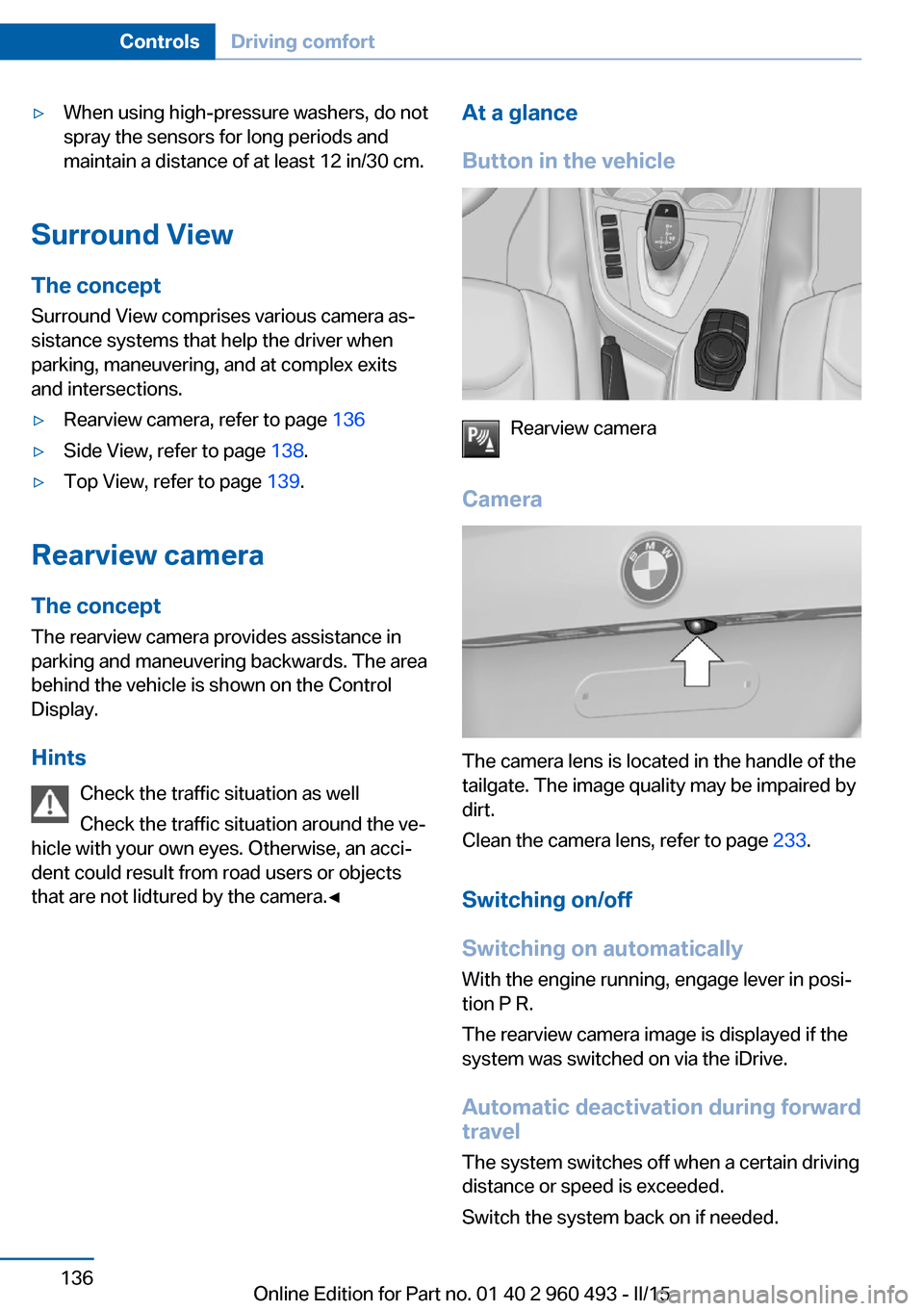
âˇWhen using high-pressure washers, do not
spray the sensors for long periods and
maintain a distance of at least 12 in/30 cm.
Surround View
The concept Surround View comprises various camera asâ
sistance systems that help the driver when
parking, maneuvering, and at complex exits
and intersections.
âˇRearview camera, refer to page 136âˇSide View, refer to page 138.âˇTop View, refer to page 139.
Rearview camera
The concept The rearview camera provides assistance in
parking and maneuvering backwards. The area
behind the vehicle is shown on the Control
Display.
Hints Check the traffic situation as well
Check the traffic situation around the veâ
hicle with your own eyes. Otherwise, an acciâ
dent could result from road users or objects
that are not lidtured by the camera.â
At a glance
Button in the vehicle
Rearview camera
Camera
The camera lens is located in the handle of the
tailgate. The image quality may be impaired by
dirt.
Clean the camera lens, refer to page 233.
Switching on/off
Switching on automatically With the engine running, engage lever in posiâ
tion P R.
The rearview camera image is displayed if the
system was switched on via the iDrive.
Automatic deactivation during forward
travel
The system switches off when a certain driving
distance or speed is exceeded.
Switch the system back on if needed.
Seite 136ControlsDriving comfort136
Online Edition for Part no. 01 40 2 960 493 - II/15